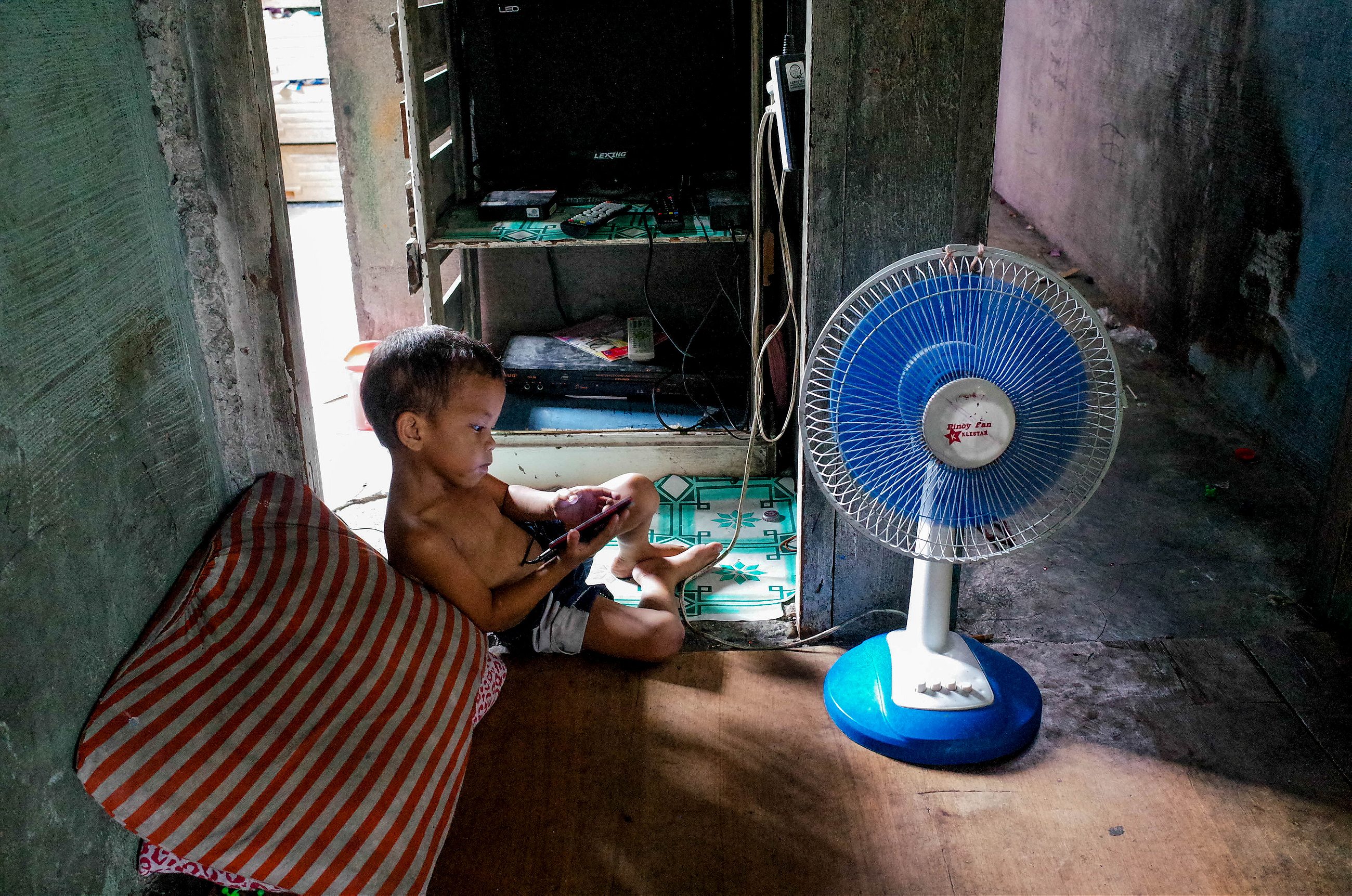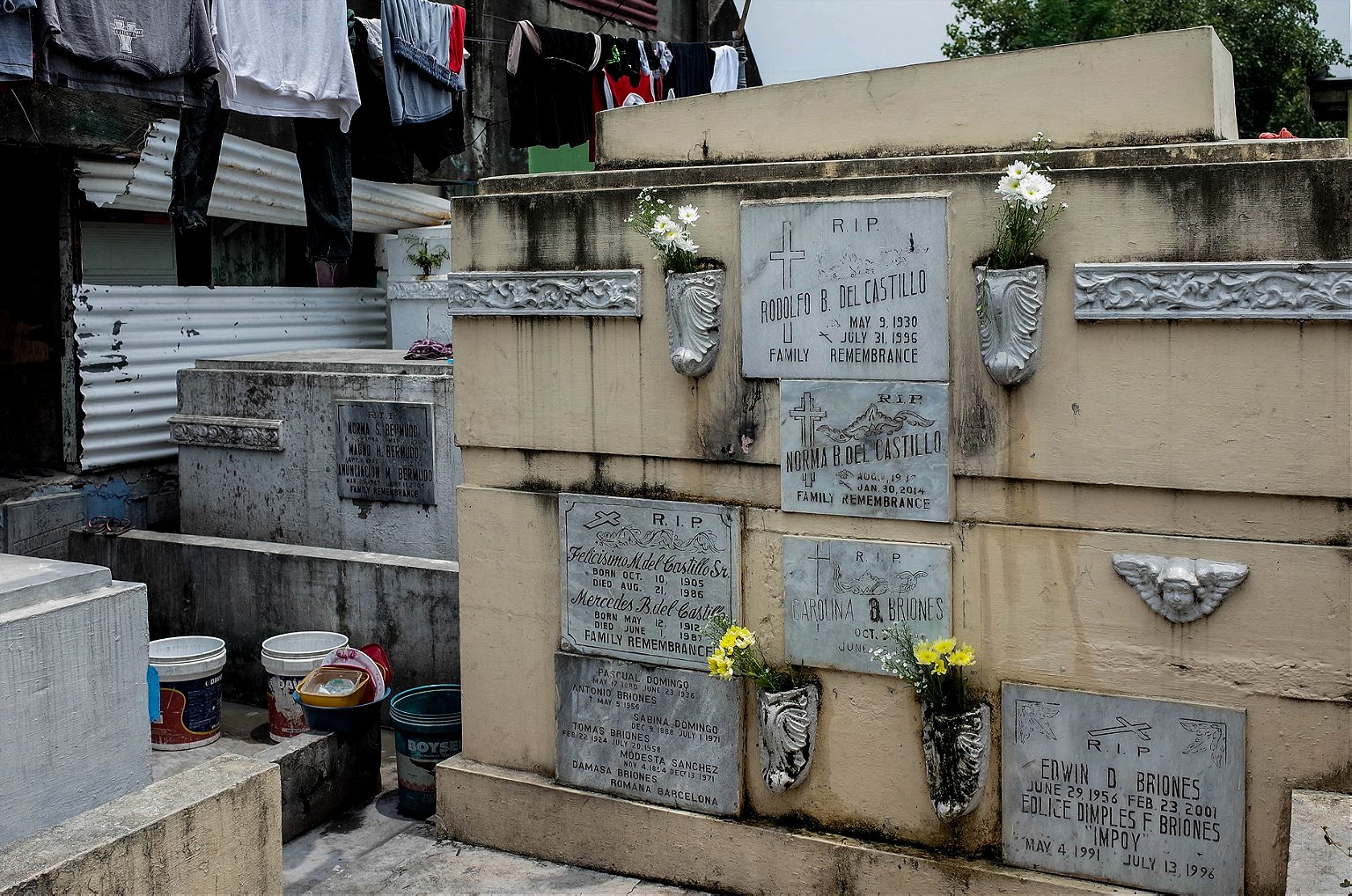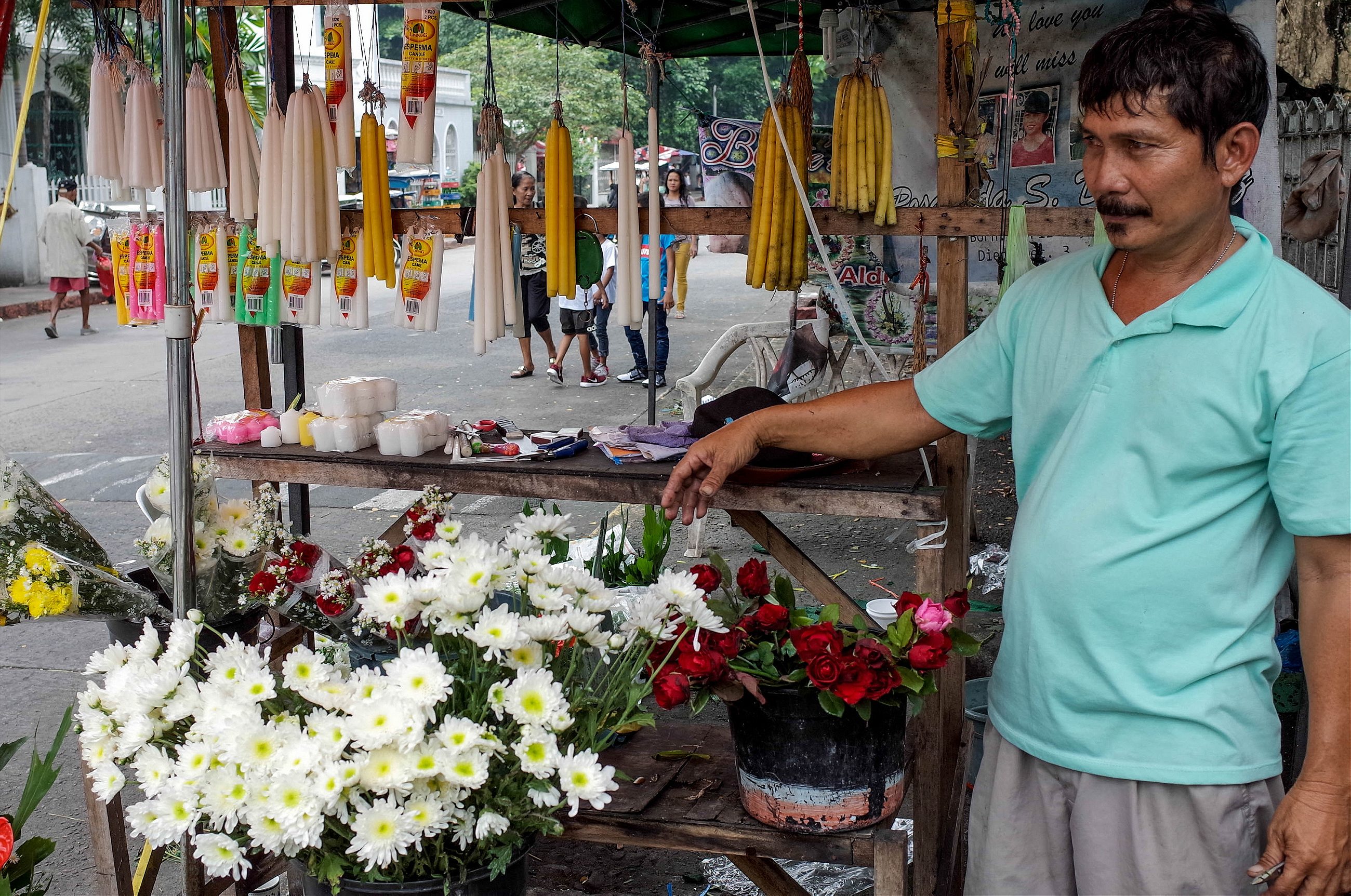Residents of the Manila North cemetery make their living caring for the deceased.
Carolyn fetches a small bucket of water to fill the concrete vases. “Bend the stems,” she says. It is a trick to prevent the flowers from being stolen and resold at the cemetery. I mix the white chrysanthemums with the yellow before placing them next to my grandfather’s tomb.
Manila is the most densely populated city in the world. Close to a quarter of its 13 million residents are illegal tenants. The Manila North Cemetery houses over a million of the dead as well as thousands of the living, mostly the city’s poorest.
The Manila North Cemetery is a fully functioning city. There is a method to the madness. People build relationships and create families within its four walls. It has a thriving economy. Illegal wires tap into the main electrical supply and power the homes here. Each week, unauthorized connections are taken down, and in an endless cycle, the residents find a way to access an open source of power again. Water is bought in plastic containers filled from a deep well inside the premises.
The cemetery is owned by the city and was laid out in 1904 on 130 acres of land, making it the largest and one of the oldest in the Philippines. The mausoleums range from simple painted tombs to complex and ornate reliefs and carvings.
It’s the resting place of a number of Philippine presidents, revolutionaries, war veterans, and celebrities. Three generations of my family on my mother’s side are buried here; my great grandparents, grandfather, and various aunts and uncles. It has been our family plot since the 1920s. My father, who is Indian, is amused with the strange attachment Filipinos have to their dead. In India, a body is cremated a day after death, traditionally by the next dusk or dawn. The ashes are then dispersed in the holy river Ganges.

Ninety percent of Filipinos are Roman Catholics, but they have their own death rituals. A lamay (vigil) is held for three nights to a week, sometimes longer if a family member is away. The coffin is brought to the house or a funeral parlor. Mourners provide abuloy, or donations, to help the family cover funeral expenses. Drinks and snacks are served throughout the vigil. Relatives and visitors play cards, gamble, and sing to stay awake as they guard their dead until the body is buried.
To get to our plot, one must walk through a dirty, narrow alley and climb over other people’s tombs. The local government through the years has sold most of the surrounding land that was meant for pathways. We are left with little choice but to keep building upwards: countless columns and rows of tombs, one on top of another. To save space, at one point the crypts were opened and the bones were combined. Crypts are rented out for five years to families who do not have a permanent space. If the terms of payment are not met, the bones are disposed of and the tombs are then offered to others.
Clothes of various shapes and sizes are hung on the railings of the mausoleums. Sunday is laundry day. I can hear someone’s television playing a noon-time soap. The place feels more cramped than my last visit.

The Mañalac family have lived next to our tombs for the past six decades. Their family migrated from the provincial town of Pampanga, north of the capital, in search of a better life in the city. Carolyn’s father squatted across from our family plot in the 1950s. Behind us, a decaying cement building serves as a mausoleum to a once wealthy Chinese family. The Mañalacs were permitted by the family to live on the second floor on the condition they serve as caretakers. Carolyn still shares the space with eight other siblings and their extended family.
A rickety roof was erected above our plot to protect visitors from the heat and rain in the early 1960s. It was destroyed numerous times before the Mañalac’s took charge of the area. Whenever a family member of ours comes to visit, they pay the family a fee to help maintain the grounds. In October, a larger sum is distributed to paint the tombs in preparation for All Souls Day in November.

Carolyn lost her father, Edwardo, to tuberculosis, a common ailment in the damp grounds of the cemetery. I remember my parents bringing him medicine. Carolyn’s mother, Milagros Mañalac, died a few years later, in 2009. She is buried in the room where they live. The room and her tomb are separated by a small, dusty curtain.
Carolyn is in her early 30s and has four children; we are nearly the same age. The hardship of living under such conditions is reflected in her face. However, her toothless smile is infectious. “I met your parents the other month; your mother sat in the car. She could not walk to the tombs anymore…” Carolyn says as she leads me into their shack. We have witnessed each other’s family grow and age.
We meet on special anniversaries, birthdays or for more obvious reasons: when there is another death in the family. Previously, our conversations were brief; it was always our parents who spoke. My first memory of visiting the cemetery is at age seven. We played among the tombs with the children who lived there.
I ask about Christina. Carolyn looks worried as she holds her four-year-old son, who is preoccupied with a game on a mobile phone. Christina is her younger sister, who has been missing for the past three months. She was born with autism and would sometimes go off on her own outside of the cemetery, sleeping on the streets of Manila. This time she has been away longer than she should. I have a soft spot for her. Christina was always happy to see me. The local barangay (police precinct) have not been helpful in finding her. Each day, Carolyn’s elder sister, Lotlot, scours the streets, hoping to bring her back home to the cemetery. “She would wander, but would always come back before sundown. We can protect her inside; it’s dangerous on the streets. “ Lotlot says.

We fumble with the strings on the last bouquet. My family has purchased such flowers from the same vendor since I was a child. The vendor, Boyet De La Cruz, has lived and sold flowers in the same spot for 30 years. Others who live here work as headstone carvers, painters, or do simple mason work. They are self-taught and pick up their trades from others who reside in the cemetery. The available work is inconsistent. The cemetery is vast, and competition is stiff. Many women set up tiny sari-sari stores that sell cigarettes, sodas, and snacks.
Sunday is always busy with funerals, but the two months leading up to November is their time to make the big bucks. To the residents, it is a fiesta of sorts. During All Souls Day and All Saints Day, it is Filipino tradition to check on the mausoleums and tombs and spend the entire day with the dead. Filipinos honor their forefathers on these two days by offering food, flowers, prayers, and candles. Some stay the night to keep their loved ones company.
There are plenty of long-term difficulties plaguing the cemetery community. Garbage trucks come infrequently, so there is a problem with sanitation. There is no system in place for resettlement or free distribution of contraceptives to help control the population, and there are no work-training or education programs available to the residents here that might help them move to more stable locations.
The Manila North Cemetery has been plagued by the police
Since President Rodrigo Duterte’s term began in June 2016, his campaign to completely eradicate drug use in the Philippines has resulted in thousands of killings, mainly perpetrated at night by gun-wielding police officers and vigilantes. None of the perpetrators have been found guilty by the courts. The Manila North Cemetery has been plagued by the police. Dealers are killed over tiny packets of shabu (methamphetamine) and guns are found near corpses. It’s mainly the poor that have been casualties of Duterte’s drug war.
“We keep our distance; the police kill two or three a week. The [residents] regret voting for him,” Carolyn says.
The rains have stopped for the first time in weeks. The cemetery looks less depressing on a sunny day. However, it is stifling to be surrounded by the tombs. A group of children are waiting outside. Their hands stretched out to greet me. It is common for them to beg and ask for change.
Adjacent to the steps is a dingy quarter. A young father is eating with his son as they sit on the floor. They are both painfully thin. They share the remaining bowl of boiled rice and dried fish with their pet dog.
“Kain, tayo.” Let’s eat, he says through the window, offering me a share of their meager meal. I smile and thank him for his generosity.
“I never teach my son to beg. We may be poor, but one must have some dignity,” he tells me.
Carolyn and I walk to the road and sit with her and her friends under a large tree. The children drag out a brightly striped inflatable pool. It takes eighty pesos ($1.50 USD) to fill it up completely with water.
Carolyn takes the stipend I pay to help maintain our lot and pays for the water for the little pool. The children play happily, a scene that could be straight out of the suburbs.

She sends a small girl to buy a liter of beer to share with the rest of the ladies as they wash their laundry by hand. I feel guilty and add cash for another bottle. A lady pulls out a swanky phone to snap a picture of us. The community in the cemetery feels safer than the slums of Manila. It may be a difficult existence, but it is a relatively quiet one.
Carolyn pours beer into a cloudy, shallow glass. She hands it to me and I drink with them for the rest of the afternoon.
Before leaving I ask her if she has ever seen ghosts in the cemetery.
Carolyn laughs and shakes her head.
“In the monsoon, when it rains hard, I feel a spirit or see a vision sometimes. But I don’t believe in ghosts. I fear the living. People kill. Why should you fear the dead? Dito tayo lahat patungo.” This is where we are all headed.
